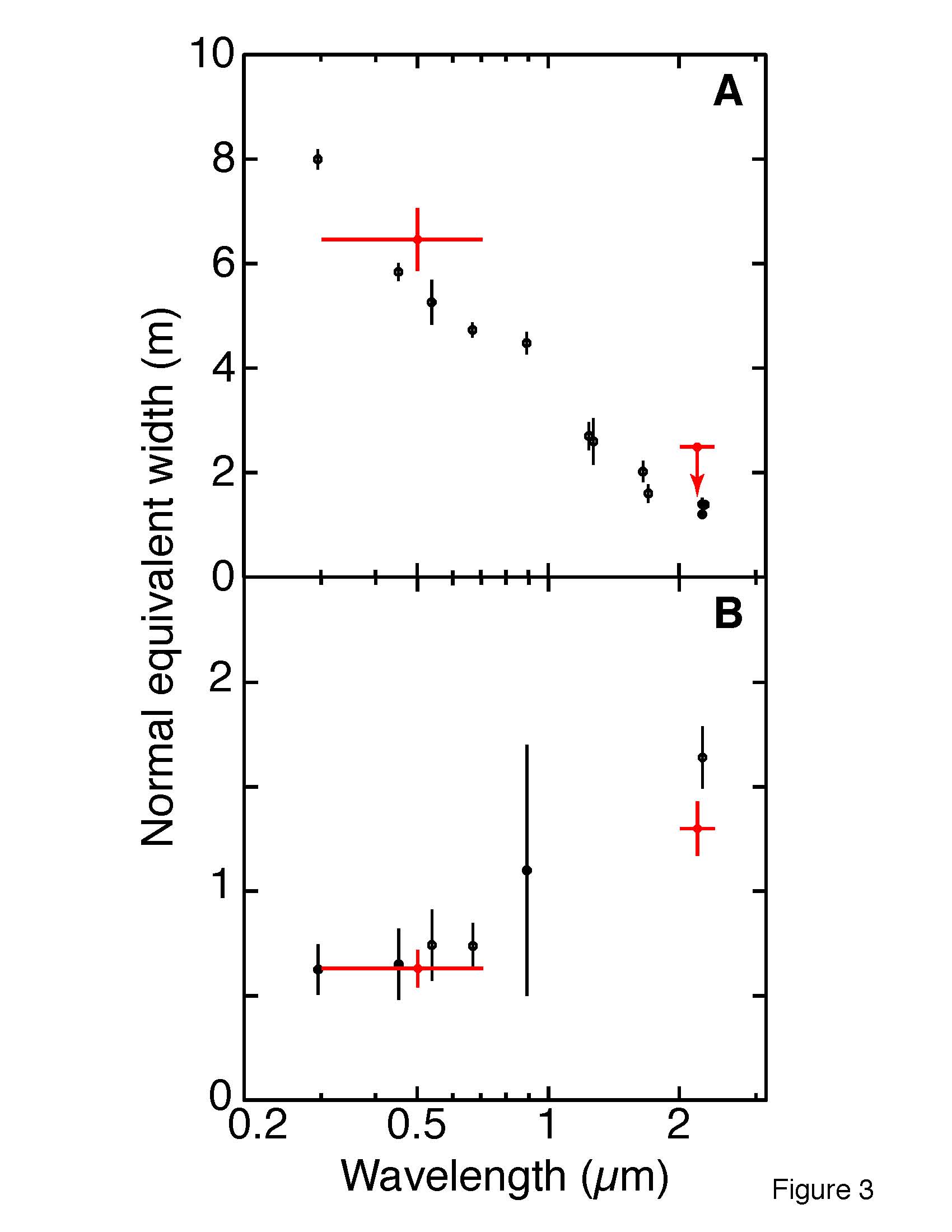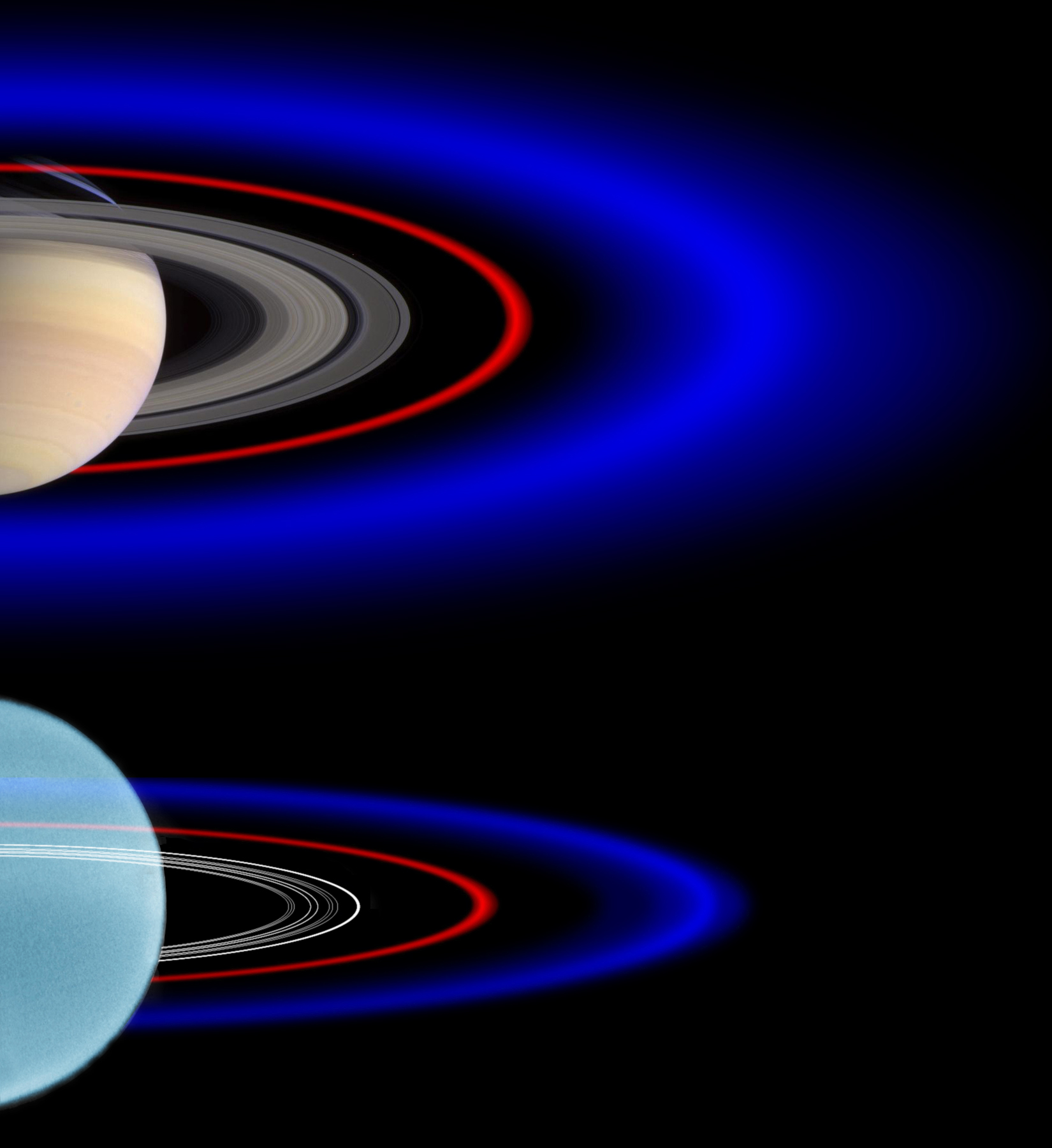
 |
||
|
Lick
Observatory, Mt.Hamilton, California
|
W.
M. Keck Observatory,
Hawaii
|
New Dust belts of Uranus:
One Ring, Two Ring, Red Ring, Blue Ring
Images and text below are from our paper in Science: de Pater, Hammel, Gibbard, and Showalter, New Dust belts of Uranus: One Ring, Two Ring, Red Ring, Blue Ring, Science, April 7, 2006, 312, 92-94. All images were obtained with the Keck adaptive optics system (NIRC2 camera) at 2.2 micron, a wavelength where sunlight is absorbed by methane and hydrogen gas in Uranus atmosphere, greatly reducing scattered light from the planet.

Keck AO images of the uranian system. Both frames cover ~70,000 km of space vertically, with Uranus S. pole pointed to the left. The main rings (their ansas) show prominently. (A) R/2003 U2 (R2) is distinctly visible off the southern ansa in August, 2005; the bottom portion of this image has been enhanced relative to the planet and main rings to better show the ring. The total integration time was 1 hr. The image has been median-filtered to remove satellites. (B) No trace of R/2003 U 1 (R1) is visible at the northern ansa in October, 2005. This is a coadded mosaic (integration times vary from 48 min to 1.5 hr), in which moving satellites appear as multiple streaks; the most prominent is Puck at 8-11 o'clock. The faint streak between Puck and the main rings is Rosalind. Juliet was visible in 1 frame (single dot). Horizontal white lines indicate the full radial limits of R1. R2 is not visible on this image. (Fig. 1 from de Pater, Hammel, Gibbard, and Showalter, 2006. Science, April 7).

Spectra of R1 compared with Saturn's E ring (A) and R2 compared with Saturn's G ring (B). Measurements of Uranus rings are shown in red, Saturn's in black. Horizontal bars indicate the range of wavelengths averaged; vertical bars indicate the 1 sigma uncertainties in the intensities (expressed as the equivalent width in meters). The radial integral of the normal equivalent width of R1 is compared to an analogous measurement of the E ring, scaled in intensity to match the R1 values. R2 and the G ring are both radial integrals and are plotted at the same scale (Fig. 3 from de Pater, Hammel, Gibbard, and Showalter, 2006. Science, April 7). The visible wavelength measurements for Uranus were derived from the HST images obtained by Showalter and Lissauer (2006; Science, vol. 311, p. 973)

A schematic view of the outer rings of Saturn and Uranus, in which each system has been scaled to a common planetary radius. We have drawn Uranus main rings to emphasize that these rings are extremely narrow. In groundbased observations the rings are blurred (see Fig. 1 above) due to limited angular resolution (seeing and telescope diameter). (Fig. 4 from de Pater, Hammel, Gibbard, and Showalter, 2006. Science, April 7).

Uranus orbits the Sun in 84 years, during which time it experiences extremes in seasons. The series of images shown here shows the slow variation in viewing geometry while it becomes fall-winter in the southern (left) hemisphere, and spring-summer in the north. In 2007 the rings will appear edge-on. (Image Courtesy: de Pater, Hammel and Gibbard).
See Full UC Berkeley Press Release for Science paper 04/07/2006 Abstract of Science paper can de downloaded here Full text of Science paper can de downloaded here Downloading high resolution versions of images above (Use credit lines as given above) See UCB announcement of R/2003 U2 from Dec. 2005 HST images and press release of both new rings from Dec. 2005